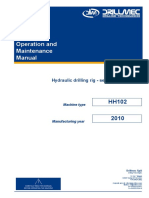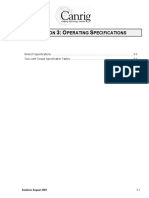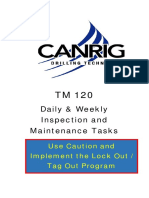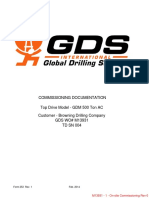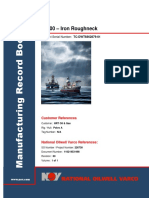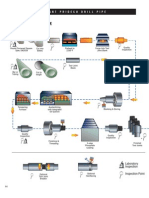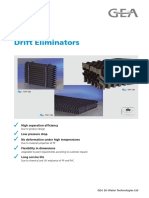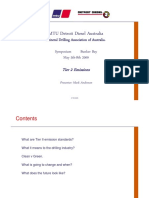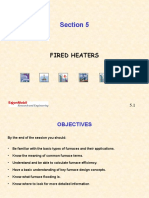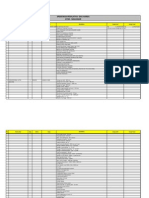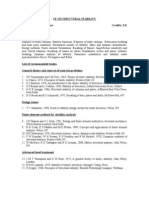Study of Dies and Inserts
Study of Dies and Inserts
Uploaded by
traidenCopyright:
Available Formats
Study of Dies and Inserts
Study of Dies and Inserts
Uploaded by
traidenOriginal Title
Copyright
Available Formats
Share this document
Did you find this document useful?
Is this content inappropriate?
Copyright:
Available Formats
Study of Dies and Inserts
Study of Dies and Inserts
Uploaded by
traidenCopyright:
Available Formats
Model: TM80/TM100/TM120
Mar. 11, 2020
Serial #: All
Product Bulletin # TM-030 v 2.0
Torq-Matic™ Wrench Die Setup Recommendations
Objective
The objective of this bulletin is to present the correct die configurations and wrench alignment
procedure to maximize the make up and break out efficiency of the Canrig® Torq-Matic™
Automated Wrench (TM wrench). Following this guide will minimize cycle time, reduce wear and
tear on the dies, and reduce residual forces that cause premature tong, jaw, and cylinder
damage.
Outer Die Options
The standard dies have been redesigned to long tooth pattern dies. These redesigned dies are
referred to as premium dies.
Premium Dies
Premium dies provide better engagement on the pipe and reduce slippage at higher torques.
The larger teeth and stronger material greatly increase the shear strength of the teeth which
result in a much longer die life than standard dies.
Standard Dies
Standard dies operate well at lower torque values; however, they do not perform as well at
higher torques. The individual teeth take less force to shear than premium dies, resulting in a
shorter lifespan.
Both premium and standard dies can be used on all sizes of drill pipe; however, it is
recommended to use premium dies when the required torque is higher than 30,000 lb-ft. See
Table 1 on page 2.
RIGLINE 24/7™ Support: 866.433.4345 | International: +1 281.774.5649 | E-mail: support@rigline247.com
Document ID 20-009 v 2.0 | Copyright © 2020 Nabors Drilling Technologies USA, Inc. All rights reserved.
1 of 14
Model: TM80/TM100/TM120
Mar. 11, 2020
Serial #: All
Table 1: Outer Dies
STANDARD PREMIUM
Recommended Torque Range
0 – 30,000 lb-ft 30,000 – 100,000 lb-ft
P/N: 161100210 P/N: R10510
Center Die Options
With the introduction of higher torque double-shoulder pipe, an extended center die was
introduced to increase the die penetration surface area on 6-5/8" diameter tool joints and larger
by adding an extra point of contact. Extended center dies greatly increase the efficiency of
making up and breaking out double-shoulder pipe, such as XT54 and Delta 544.
The standard center die is recommended to be used on all tool joints (TJ) with outer diameters
(OD) less than 6-5/8". See Table 2 below and Figure 1 and Figure 2 on page 3.
Table 2: Center Dies
STANDARD EXTENDED
Recommended Pipe Diameter
TJ OD < 6-5/8" TJ OD ≥ 6-5/8"
• TM80/100 – P/N: R10509
P/N: R10272
• TM120 – P/N: R10525
RIGLINE 24/7™ Support: 866.433.4345 | International: +1 281.774.5649 | E-mail: support@rigline247.com
Document ID 20-009 v 2.0 | Copyright © 2020 Nabors Drilling Technologies USA, Inc. All rights reserved.
2 of 14
Model: TM80/TM100/TM120
Mar. 11, 2020
Serial #: All
Ø 6.625 Tool Joint Ø 6.625 Tool Joint
Figure 1: With Standard Center Dies Figure 2: With Extended Center Dies
CENTER OUTER CENTER OUTER
Outer: Pyramid Tooth Pattern (Standard dies) Outer: Long Tooth Pattern (Premium dies)
Center: Standard Center: Extended
Figure 3: Standard Dies Configuration Figure 4: Premium Dies Configuration
RIGLINE 24/7™ Support: 866.433.4345 | International: +1 281.774.5649 | E-mail: support@rigline247.com
Document ID 20-009 v 2.0 | Copyright © 2020 Nabors Drilling Technologies USA, Inc. All rights reserved.
3 of 14
Model: TM80/TM100/TM120
Mar. 11, 2020
Serial #: All
Die Performance Chart
The following chart depicts the XT54 make up torque using the different die options available for
the TM wrench.
Note: This test was performed on a TM80 comparing die
performance up to the TM80's maximum rated make up torque of
60,000 lb-ft.
XT54 Max Torque vs. Die Configuration
70000
Maximum Makeup Torque (lb-ft)
60000
50000
40000
30000
20000
10000
0
Premium+Extended Center Premium Only Standard+Extended Center Standard Only
Figure 5: Die Performance Chart
RIGLINE 24/7™ Support: 866.433.4345 | International: +1 281.774.5649 | E-mail: support@rigline247.com
Document ID 20-009 v 2.0 | Copyright © 2020 Nabors Drilling Technologies USA, Inc. All rights reserved.
4 of 14
Model: TM80/TM100/TM120
Mar. 11, 2020
Serial #: All
Die Guidelines
Proper die placement will prevent slippage and premature wear on the dies. It will also allow the
TM wrench to properly make up and break out the tubular joints. The dies must clear the pipe
hard banding to engage the surface of the pipe. To achieve this, use spacers to offset metal dies.
See Figure 6.
Hard Banding
Gripper Rollers
Standard Drill Pipe
Hard Bands
Upper Tong
Pin End
Dies with Spacers
Box End
Lower Tong
Hard Bands
Figure 6: Using Spacers to Clear Hard Banding
RIGLINE 24/7™ Support: 866.433.4345 | International: +1 281.774.5649 | E-mail: support@rigline247.com
Document ID 20-009 v 2.0 | Copyright © 2020 Nabors Drilling Technologies USA, Inc. All rights reserved.
5 of 14
Model: TM80/TM100/TM120
Mar. 11, 2020
Serial #: All
Shoulder Placement
Die configurations depend upon the size of the pipe being utilized. Do not place dies in locations
where the die will come into contact with the tubular hard bands. As a guideline, it is
recommended dies engage at least 3 inches from the shoulder of double shoulder pipe to
prevent pipe deformation; however, check with the pipe manufacturer for detailed instructions.
Dies are recommended to be placed in a configuration in which dies clear hard banding and
give shoulder clearance. See Figure 7.
DIES
3" MINIMUM
FROM SHOULDER
SPACERS
RECOMMENDED
TONGING AREA
Figure 7: Lower Tong Shoulder Placement
RIGLINE 24/7™ Support: 866.433.4345 | International: +1 281.774.5649 | E-mail: support@rigline247.com
Document ID 20-009 v 2.0 | Copyright © 2020 Nabors Drilling Technologies USA, Inc. All rights reserved.
6 of 14
Model: TM80/TM100/TM120
Mar. 11, 2020
Serial #: All
Die Configurations
TM80/100 Die Configurations
HARDBANDING ACCOMMODATION STANDARD
UPPER
OR
LOWER
TONG DIE
CONFIGURATIONS
Figure 8: TM80/100 Die Configurations
TM120 Die Configurations
STANDARD / HIGH TORQUE
HARDBANDING ACCOMMODATION DOUBLE SHOULDER PIPE (60,000 lb-ft AND UP)
UPPER
OR
LOWER
TONG DIE
CONFIGURATIONS
STANDARD STANDARD STANDARD STANDARD STANDARD
UPPER LOWER UPPER LOWER UPPER & LOWER
Figure 9: TM120 Die Configurations
RIGLINE 24/7™ Support: 866.433.4345 | International: +1 281.774.5649 | E-mail: support@rigline247.com
Document ID 20-009 v 2.0 | Copyright © 2020 Nabors Drilling Technologies USA, Inc. All rights reserved.
7 of 14
Model: TM80/TM100/TM120
Mar. 11, 2020
Serial #: All
Dies and Spacers Part Numbers
Table 3: TM Wrench Dies and Spacers
Canrig P/N Description Notes
FULL DIES
161100210 FULL DIE, STANDARD, TM80/100/120 PYRAMID TOOTH
R10510 FULL DIE, PREMIUM, TM80/100/120 LONG TOOTH
CENTER DIES
R10272 CENTER DIE, STANDARD, TM80/100/120 FOR LESS THAN 6-5/8" TOOL JOINT
R10509 CENTER DIE, EXTENDED, TM80/100 FOR GREATER THAN 6-5/8" TOOL JOINT
R10525 CENTER DIE, EXTENDED, TM120 FOR GREATER THAN 6-5/8" TOOL JOINT
HALF DIES
PYRAMID TOOTH
DT51537 HALF DIE, STANDARD, TM120
Note: Not offered on TM80/100.
LONG TOOTH
R10521 HALF DIE, PREMIUM, TM120
Note: Not offered on TM80/100.
SPACERS
141500052 HALF DIE SPACER, TM80/100
161500005 FULL DIE SPACER, TM120
DT51006 HALF DIE SPACER, TM120
DT52490 CENTER DIE SPACER, TM120
RIGLINE 24/7™ Support: 866.433.4345 | International: +1 281.774.5649 | E-mail: support@rigline247.com
Document ID 20-009 v 2.0 | Copyright © 2020 Nabors Drilling Technologies USA, Inc. All rights reserved.
8 of 14
Model: TM80/TM100/TM120
Mar. 11, 2020
Serial #: All
Wrench Alignment
If the wrench is not properly aligned before torqueing the tool joint, the wrench will shift into
alignment during the make-up or break-out cycle. When the wrench shifts, the dies slip and the
jaw cylinders may get pushed back, despite being under full pressure, if the opposing cylinders
are offset as shown in Figure 10. Ensuring the wrench is aligned with the drill pipe will significantly
increase the efficiency of the wrench and greatly reduce premature damage to the dies, tong,
jaw, and cylinder. Adding a jaw synchronizing kit will center the wrench side-side reducing much
of the residual forces, however the wrench must still be centered front-back.
The TM wrench tongs must be parallel to the rig floor to properly align to pipe. The TM wrench’s
center of gravity can be adjusted to achieve this. A Canrig technician can perform these
mechanical adjustments to the center of gravity.
Ensure clamps are closing at the same speed and distance (centered side-to-side) if a jaw
synchronizing kit is not installed. A jaw synchronizing kit can be ordered and installed on wrenches
experiencing this issue.
Contact RIGLINE 24/7™ Support to purchase a kit and request for a Canrig technician to perform
the clamp jaw synchronizing hydraulic system upgrade. See Table 4 on page 10.
Offset Clamps Aligned Clamps
Figure 10: TM Wrench Clamps
RIGLINE 24/7™ Support: 866.433.4345 | International: +1 281.774.5649 | E-mail: support@rigline247.com
Document ID 20-009 v 2.0 | Copyright © 2020 Nabors Drilling Technologies USA, Inc. All rights reserved.
9 of 14
Model: TM80/TM100/TM120
Mar. 11, 2020
Serial #: All
Jaw Synchronizing Kits
Table 4: Jaw Synchronizing Kits
Canrig P/N Description
TM80
AY51461 KIT, JAW SYNCHRONIZING, TM80
TM120
AY51790 KIT, JAW SYNCHRONIZING, TM-120, V1.3
AY51793 KIT, JAW SYNCHRONIZING, TM-120, V1.2
Damaged or worn dies must be replaced to prevent slippage and to properly align the wrench.
Figure 11: Dies Within Proper Wear
RIGLINE 24/7™ Support: 866.433.4345 | International: +1 281.774.5649 | E-mail: support@rigline247.com
Document ID 20-009 v 2.0 | Copyright © 2020 Nabors Drilling Technologies USA, Inc. All rights reserved.
10 of 14
Model: TM80/TM100/TM120
Mar. 11, 2020
Serial #: All
Alignment Procedure
Warning!
Ensure that only trained personnel conducts
the following procedure and are wearing
appropriate PPE. Use proper precautions and
ensure that proper communication with the TM
operator are established and followed.
1. Manually extend the TM wrench to hole center or mouse hole.
1.1. Move the wrench using “Maintenance Mode” screens on wrenches with Allen-Bradley
(A/B) controller, or “Device Test” screens on wrenches with OMRON controller.
1.2. Move the TM wrench forward to grab the pipe. Extend or retract the TM wrench as
required.
1.3. Acknowledge that the TM wrench is aligned at the center to the pipe. Rotate left or right
as required.
2. Align the tongs to the joint.
Figure 12: Tongs Aligned to Pipe Joint
RIGLINE 24/7™ Support: 866.433.4345 | International: +1 281.774.5649 | E-mail: support@rigline247.com
Document ID 20-009 v 2.0 | Copyright © 2020 Nabors Drilling Technologies USA, Inc. All rights reserved.
11 of 14
Model: TM80/TM100/TM120
Mar. 11, 2020
Serial #: All
3. Slightly close the lower clamps.
3.1. With precaution, slightly close the lower clamps and activate the TM wrench’s E-Stop.
(Verify that the TM wrench is immobile). Looking from above, check to see if the back
dies are in line to grab the pipe.
Figure 13: Clamps Slightly Closed
3.1.1. Extend or retract the TM as required.
3.2. If all dies will equally grab the pipe, disengage the TM wrench’s E-Stop and fully close
clamps on to the pipe. Activate the TM wrench’s E-Stop and double check that all dies
are seated on the pipe equally.
Figure 14: Left Hand Side Seated Dies Figure 15: Right Hand Side Seated Dies
RIGLINE 24/7™ Support: 866.433.4345 | International: +1 281.774.5649 | E-mail: support@rigline247.com
Document ID 20-009 v 2.0 | Copyright © 2020 Nabors Drilling Technologies USA, Inc. All rights reserved.
12 of 14
Model: TM80/TM100/TM120
Mar. 11, 2020
Serial #: All
4. Once proper alignment has been acquired, navigate to the Horizontal Settings screen and
set Hole Center or Mouse Hole.
Figure 16: A/B Horizontal Vertical Screen
Figure 17: OMRON Settings Screen
RIGLINE 24/7™ Support: 866.433.4345 | International: +1 281.774.5649 | E-mail: support@rigline247.com
Document ID 20-009 v 2.0 | Copyright © 2020 Nabors Drilling Technologies USA, Inc. All rights reserved.
13 of 14
Model: TM80/TM100/TM120
Mar. 11, 2020
Serial #: All
Wrench Centered Study
Slipping case studies demonstrate that slippage occurs when the pipe is not centered properly
with the wrench. The wrench center is the optimal position for the dies as this allows the dies to
make full contact with the pipe while in make up and break out. Off-centered piping yielded
with 2,044 ft/hr while centered pipe yielded 3,242 ft/hr. See Figure 18.
Wrench Not Centered
Wrench Not Centered
2,044 ft/hr
Wrench Centered
3,242 ft/hr
3,438 ft/hr
Wrench Centered
AFTER ADDING CENTER DIES – TRIP OUT
Figure 18: Wrench Centered Study
RIGLINE 24/7™ Support: 866.433.4345 | International: +1 281.774.5649 | E-mail: support@rigline247.com
Document ID 20-009 v 2.0 | Copyright © 2020 Nabors Drilling Technologies USA, Inc. All rights reserved.
14 of 14
You might also like
- Massey Ferguson MF 3635 TRACTOR Service Parts Catalogue Manual (Part Number 1637256)Document14 pagesMassey Ferguson MF 3635 TRACTOR Service Parts Catalogue Manual (Part Number 1637256)qlb898316No ratings yet
- ETL Yanmar Schneefraese YSR 1820 - 2220 - 2720Document115 pagesETL Yanmar Schneefraese YSR 1820 - 2220 - 2720linnorman123No ratings yet
- Parts List EMI 450Document185 pagesParts List EMI 450Mauricio Garcia100% (1)
- ZY-ZJ-800&1000 Operation & Maintenance Manual PDFDocument69 pagesZY-ZJ-800&1000 Operation & Maintenance Manual PDFOperaciones Gep100% (1)
- 2M Tek Torq Tek ZIIDocument1 page2M Tek Torq Tek ZIIamghardjillali_449230% (1)
- Pages From PS 21 NOVDocument1 pagePages From PS 21 NOVHanyNo ratings yet
- Especificaciones Tecnicas Um189030 - e PDFDocument136 pagesEspecificaciones Tecnicas Um189030 - e PDFWilson CendalesNo ratings yet
- Jet Pumping Oil Wells, Guiberson, WO, 1983 & 1984, 18 PgsDocument18 pagesJet Pumping Oil Wells, Guiberson, WO, 1983 & 1984, 18 PgsAnonymous Xy309m9Sm9100% (2)
- Itag Ibop ValveDocument23 pagesItag Ibop ValveValmac ServicesNo ratings yet
- Canrig TM80/120 SpecsDocument16 pagesCanrig TM80/120 Specsaris4silveyraNo ratings yet
- Blohm + Voss Mini Floorhand 9GF-8002 R2Document93 pagesBlohm + Voss Mini Floorhand 9GF-8002 R2Jeisson David Velandia MendivelsoNo ratings yet
- Torq-Matic Automated Floor Wrench: Preventive Maintenance Guide (Model TM120-110/125)Document1 pageTorq-Matic Automated Floor Wrench: Preventive Maintenance Guide (Model TM120-110/125)Alejandra Noguera GiraldoNo ratings yet
- Item 1 - Ficha Tecnica IBOP Upper Canrig 1250 ACDocument6 pagesItem 1 - Ficha Tecnica IBOP Upper Canrig 1250 ACanghelo marquezNo ratings yet
- Forum B+V 70370 - S - D - Manual - Tongs - Rev - 010 - enDocument138 pagesForum B+V 70370 - S - D - Manual - Tongs - Rev - 010 - enrenjith rsNo ratings yet
- Dies Inserts Catalog Low ResolutionDocument48 pagesDies Inserts Catalog Low ResolutionAlvin Garcia Palanca100% (1)
- HTD SeriesDocument5 pagesHTD SeriesDharmendra khatriNo ratings yet
- Product Information Bulletin: Handling ToolsDocument7 pagesProduct Information Bulletin: Handling ToolsghanNo ratings yet
- TM 120 Daily and Weekly Inspection and Maintenance TasksDocument23 pagesTM 120 Daily and Weekly Inspection and Maintenance TasksAlejandra Noguera GiraldoNo ratings yet
- NOV Elevator Link CompatibilityDocument2 pagesNOV Elevator Link CompatibilityisamelgqNo ratings yet
- 1000012667-PIB Shot PinDocument3 pages1000012667-PIB Shot PinAdrian CantaragiuNo ratings yet
- Manuel #1043575 (FM594, FM593, FM595, FM596) Rig 51-Funza-53-TenjoDocument99 pagesManuel #1043575 (FM594, FM593, FM595, FM596) Rig 51-Funza-53-TenjoJohn Alexander Bonilla AngelNo ratings yet
- Blowout Preventers CompressedDocument28 pagesBlowout Preventers CompressedMuthia AstriNo ratings yet
- Drill Pipe Connection SizesDocument4 pagesDrill Pipe Connection Sizesفؤاد ابوزيدNo ratings yet
- HH-Travling BlockDocument3 pagesHH-Travling Blockabdi rachman100% (2)
- MM Gad Racr 306 PDFDocument1 pageMM Gad Racr 306 PDFNasreddine SiaghNo ratings yet
- DrillPipe, 80%, 5.000 OD, 0.362 Wall, IEU, X-95.. XT50 (6.625 X 3.938)Document3 pagesDrillPipe, 80%, 5.000 OD, 0.362 Wall, IEU, X-95.. XT50 (6.625 X 3.938)Johann Zabaleta100% (1)
- Arranque de GDSDocument59 pagesArranque de GDSToño ToñoNo ratings yet
- Manual TD GDSDocument417 pagesManual TD GDSjose manuel LázaroNo ratings yet
- Automated Power CatwalkDocument6 pagesAutomated Power CatwalkianherzogNo ratings yet
- FORUM General Catalog Handling Tools 2017Document88 pagesFORUM General Catalog Handling Tools 2017Eduardo Braga100% (1)
- 01 - Field Inspection Procedure For Used uLTIMATE™ Extreme™ Torque Connections (uXT™) PC-17 PDFDocument5 pages01 - Field Inspection Procedure For Used uLTIMATE™ Extreme™ Torque Connections (uXT™) PC-17 PDFKarla HernandezNo ratings yet
- Shaffer Ram & Spherical Blowout Preventer PartsDocument5 pagesShaffer Ram & Spherical Blowout Preventer PartsJIN WANGNo ratings yet
- Packard CatalogDocument22 pagesPackard Catalogcrni roko100% (1)
- Drill Pipe Performance SheetDocument3 pagesDrill Pipe Performance Sheetjinyuan74No ratings yet
- Cameron EB 555 D Rev U2 - VBR Engineering InfoDocument6 pagesCameron EB 555 D Rev U2 - VBR Engineering InfoCanrig Ramde100% (1)
- Shaffer Elastomer Op LimitsDocument1 pageShaffer Elastomer Op LimitsWaleed Barakat Maria100% (1)
- Master Bushing-Insert Bowls - API 7KDocument2 pagesMaster Bushing-Insert Bowls - API 7KcristinelbNo ratings yet
- Demco Gate ValveDocument52 pagesDemco Gate Valver_ergin100% (2)
- Encoder: Technical Manual 222115-001 40223723-SeriesDocument34 pagesEncoder: Technical Manual 222115-001 40223723-SeriesAndres NavarroNo ratings yet
- Restsco01 PDFDocument13 pagesRestsco01 PDFAly Kamal SabbahNo ratings yet
- Hinged Master Bushings "HMB": Den-Con Tool Company Data Book & Technical / Operational / Service ManualDocument15 pagesHinged Master Bushings "HMB": Den-Con Tool Company Data Book & Technical / Operational / Service ManualJacekNo ratings yet
- TM 120 Commissioning Manual - Rev.01 REVISADODocument32 pagesTM 120 Commissioning Manual - Rev.01 REVISADOjaimeNo ratings yet
- Manual: CDQ (S) Sucker Rod ElevatorsDocument5 pagesManual: CDQ (S) Sucker Rod ElevatorsDarshan MakwanaNo ratings yet
- Index: Bop Repair & Machine, IncDocument53 pagesIndex: Bop Repair & Machine, IncEulises renteria ramosNo ratings yet
- Mckissick Oilfield Servicing & Drilling BlocksDocument8 pagesMckissick Oilfield Servicing & Drilling BlocksPrejit RadhakrishnaNo ratings yet
- SL Manual Lock 13 58 SHAFFER RAM BOP Page-36-40Document5 pagesSL Manual Lock 13 58 SHAFFER RAM BOP Page-36-40Richard EVNo ratings yet
- 5.5in Dp 0.415wt Ht55质量文件包裹模板Document21 pages5.5in Dp 0.415wt Ht55质量文件包裹模板zhaibo666No ratings yet
- Nov Bushings Slips ClampsDocument8 pagesNov Bushings Slips ClampsRICHARDNo ratings yet
- Canrig TDS NDT Manual PDFDocument35 pagesCanrig TDS NDT Manual PDFThomson JosephNo ratings yet
- Iron Roughneck ST-100Document32 pagesIron Roughneck ST-100Almir RodriguesNo ratings yet
- Cameron BOP WeightDocument2 pagesCameron BOP WeightMurali SambandanNo ratings yet
- Canister Guard Lower Top Drive Safety Valve: 1) This Assembly Is Only Applicable To The 3-82 Canister SizeDocument1 pageCanister Guard Lower Top Drive Safety Valve: 1) This Assembly Is Only Applicable To The 3-82 Canister SizeКонструкторский отдел РосНефтеГазИнструментNo ratings yet
- Canister Guard Bottom Load Upper Top Drive Safety Valve: NotesDocument1 pageCanister Guard Bottom Load Upper Top Drive Safety Valve: NotesNasreddine SiaghNo ratings yet
- Pipe Handler Machine - 10909071-PIBDocument2 pagesPipe Handler Machine - 10909071-PIBPopovici AlexandruNo ratings yet
- Catalogue Smi PDFDocument24 pagesCatalogue Smi PDFegsge100% (1)
- HH SwivelDocument3 pagesHH SwivelHoracio LafuenteNo ratings yet
- ST160 Service ManualDocument158 pagesST160 Service ManualOscar RomeroNo ratings yet
- Drill Pipe MakingDocument2 pagesDrill Pipe MakingamithakimNo ratings yet
- Measurement While Drilling: Signal Analysis, Optimization and DesignFrom EverandMeasurement While Drilling: Signal Analysis, Optimization and DesignNo ratings yet
- AVM DynamicDocument6 pagesAVM DynamicMalwinder SinghNo ratings yet
- TD EGGER Eurospan PB TSCA 188 en USDocument2 pagesTD EGGER Eurospan PB TSCA 188 en USRely TokNo ratings yet
- Drift Eliminators: Product ProfileDocument2 pagesDrift Eliminators: Product ProfileYohanes Joko TriyantoNo ratings yet
- GLXXMobil DTE Named SeriesDocument3 pagesGLXXMobil DTE Named Seriesjesusjj01No ratings yet
- JAB Shaker Operation ManualDocument84 pagesJAB Shaker Operation ManualtraidenNo ratings yet
- Operation Manual For TA ElevatorDocument7 pagesOperation Manual For TA ElevatortraidenNo ratings yet
- Legal Spare Part List of Tong DiesDocument3 pagesLegal Spare Part List of Tong DiestraidenNo ratings yet
- Details of Certificates For Solid ControlDocument10 pagesDetails of Certificates For Solid ControltraidenNo ratings yet
- Notes and Data of Dies and InsertDocument9 pagesNotes and Data of Dies and InserttraidenNo ratings yet
- GMT Hydraulic Rotating CylindersDocument2 pagesGMT Hydraulic Rotating Cylindersgovindsr100% (1)
- 2 R 23 MechDocument48 pages2 R 23 MechTejas BaluNo ratings yet
- Gujarat Technological UniversityDocument2 pagesGujarat Technological UniversityShivam PanchalNo ratings yet
- Mark Anderson MTU Tier 2 EmissionsDocument24 pagesMark Anderson MTU Tier 2 Emissionscristian picadoNo ratings yet
- PRO 1000 Vertical Non Programmable Thermostat Installation GuideDocument24 pagesPRO 1000 Vertical Non Programmable Thermostat Installation GuideEnrique EspinosaNo ratings yet
- Transport PhenoDocument37 pagesTransport PhenoPrashant YadavNo ratings yet
- 3 Phase Motor ConnectionDocument2 pages3 Phase Motor ConnectionJafarShoja100% (1)
- En Eng Kd83v16-5aes ADocument4 pagesEn Eng Kd83v16-5aes Anguyenbinh20No ratings yet
- Engineering Mechanics Lecture 1Document15 pagesEngineering Mechanics Lecture 1Khalid YousafNo ratings yet
- Econoveyor ManualDocument25 pagesEconoveyor ManualCarlos MendozaNo ratings yet
- Appendix-G Y-Type StrainersDocument2 pagesAppendix-G Y-Type StrainerssyedNo ratings yet
- Internship Report FormatDocument14 pagesInternship Report FormatVikashKumarMahtoNo ratings yet
- 4-Eclairage 6pDocument69 pages4-Eclairage 6pghhNo ratings yet
- Technical Data: 400 Series 404A-22G1Document10 pagesTechnical Data: 400 Series 404A-22G1DEEPAKNo ratings yet
- PID Controller Design For Semi-Active Car Suspension Based On Model From Intelligent System IdentificationDocument4 pagesPID Controller Design For Semi-Active Car Suspension Based On Model From Intelligent System IdentificationSyeda Rida AbbasNo ratings yet
- Package Dyeing MachineDocument4 pagesPackage Dyeing MachineMonjur MorshedNo ratings yet
- 1.spesifikasi Peralatan MesinDocument4 pages1.spesifikasi Peralatan MesinMuhammad Luthfi SonjayaNo ratings yet
- Mechanical Product Handbook 15th EditionDocument606 pagesMechanical Product Handbook 15th EditionEsteban GNo ratings yet
- PFI ES 24 Pipe Bending and TollerancesDocument12 pagesPFI ES 24 Pipe Bending and TollerancesArcadio DuranNo ratings yet
- Effects of The Swirl Ratio and InjectDocument11 pagesEffects of The Swirl Ratio and InjectDoan Minh ThanhNo ratings yet
- Rebar Weld PDFDocument1 pageRebar Weld PDFZebNo ratings yet
- Applied Mechanics Department APL106 MECHANICS of FLUIDS (3-1-0) Semester I (2021-22) ADocument2 pagesApplied Mechanics Department APL106 MECHANICS of FLUIDS (3-1-0) Semester I (2021-22) ARakesh KumarNo ratings yet
- Engineering DetailDocument30 pagesEngineering DetailSatyaprakash PrakashNo ratings yet
- PTB Kamiai 00cDocument2 pagesPTB Kamiai 00cElmaNo ratings yet
- Course On Structural StabilityDocument3 pagesCourse On Structural StabilityVenkatesh ReddyNo ratings yet
- US6048427.pdf PA 21 PDFDocument15 pagesUS6048427.pdf PA 21 PDFVansala GanesanNo ratings yet
- Ek Question SepareteDocument17 pagesEk Question SepareteAnkit GujralNo ratings yet






